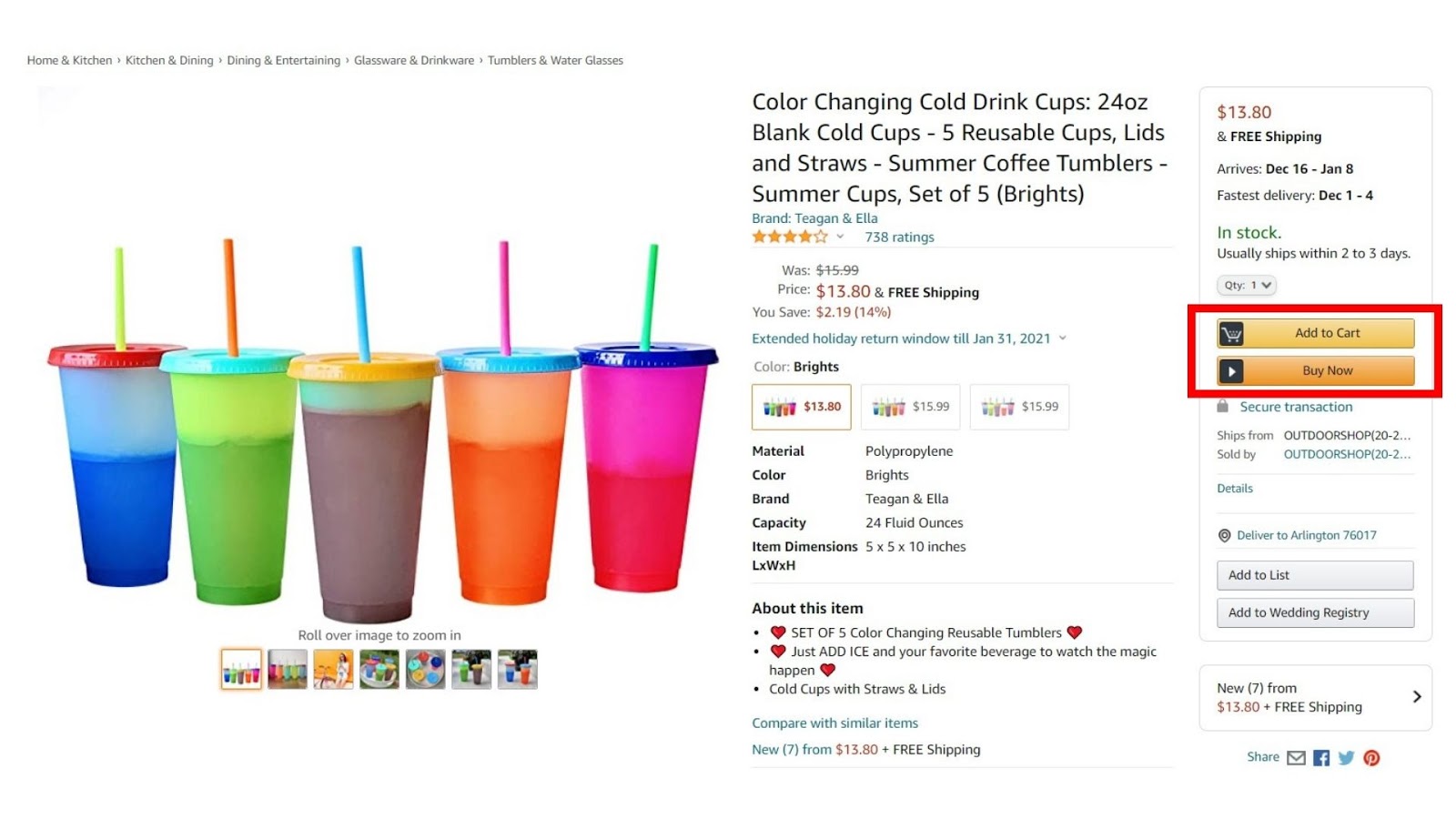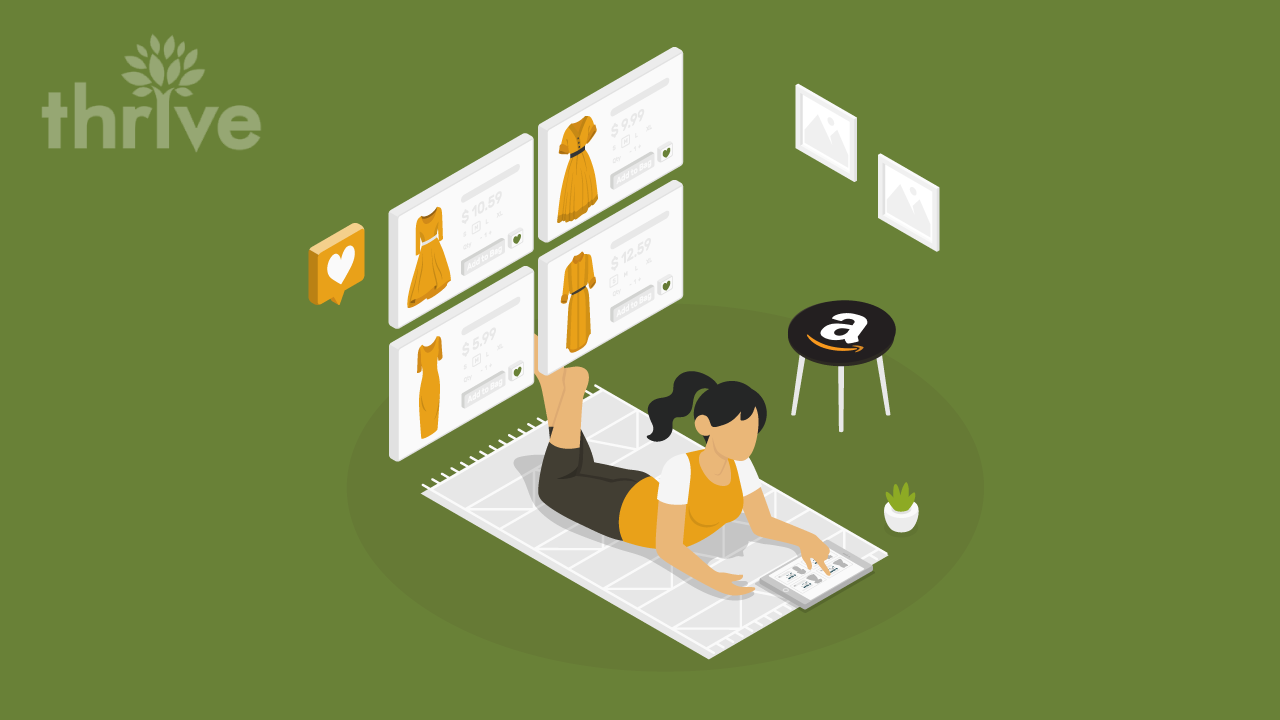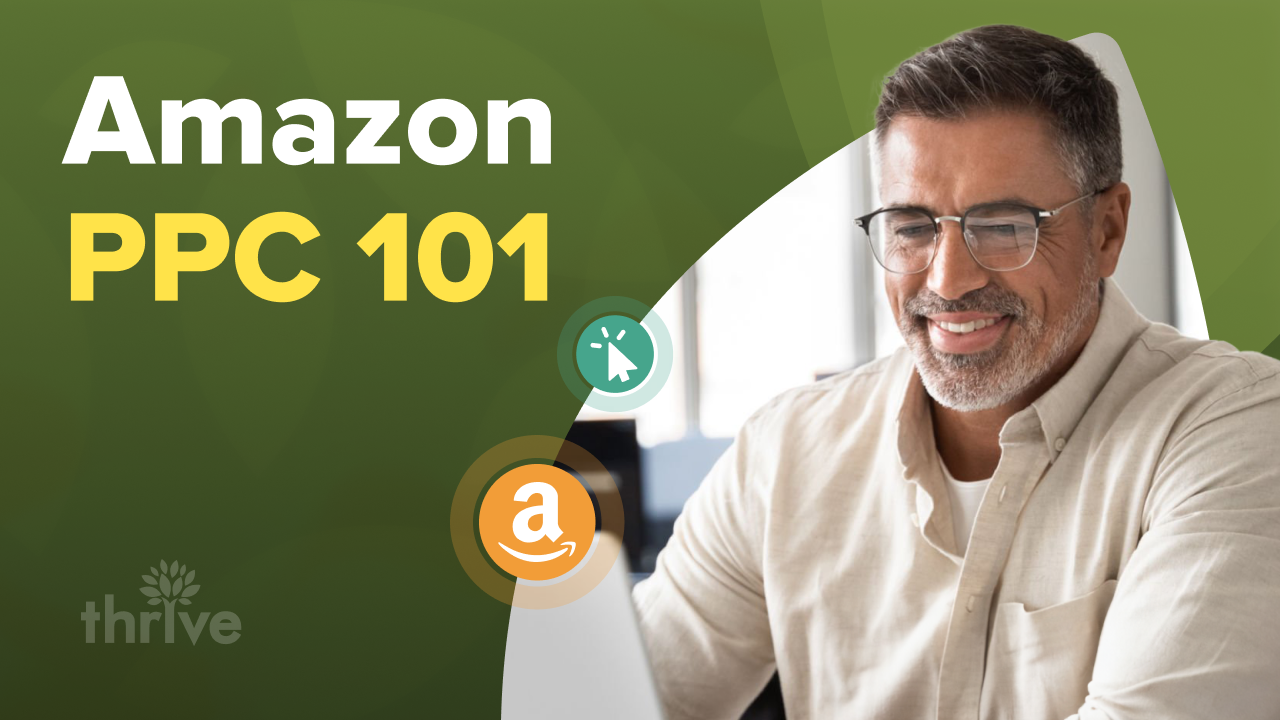With Amazon’s explosive growth in 2020, the need to optimize your product listings has never been more relevant. Finding and using proven Amazon listing optimization techniques can make your products stand out in a marketplace with thousands of competitors. Optimizing your Amazon listings is how you boost your sales and grow your customer base on this popular eCommerce platform.
Amazon listing optimization is the process of improving your Amazon product listings to increase product views and sales. Before your target audience can become your customer, they need to find your products. Strategies such as search engine optimization (SEO) influence the Amazon ranking algorithm to favor your products and display them to your potential customers.
Amazon is all about putting the customer experience first — Amazon SEO techniques are based on this principle. The algorithm will decide if your listing is relevant and delivers value to the customer based on your product details. Find out what search terms or keywords your potential customers would use to find a product like yours and include them in your listing to optimize your product detail pages for search.
Implementing a targeted keyword strategy bridges the gap between your potential customer’s needs and your product offerings. Your keyword usage tells Amazon that you have what the customer is looking for, qualifying you to rank higher on search results and making it easier for your ideal customer to find you online.
In this blog, we explain how to optimize listing Amazon products to capture a broader audience, increase traffic to your product pages and generate more sales. We discuss:
• The most important Amazon optimization terms
• Understanding Amazon listing optimization
• How to optimize an Amazon listing to boost your sales
• What to look for in an Amazon listing optimization service
• Growing your customer base with Amazon optimization expertise
7 Amazon Terms Every Seller Should Know
We know what you’re thinking — “I want to optimize my Amazon listing, but where do I start?”
Before you learn how to optimize Amazon product listing search visibility, a complete understanding of the Amazon platform is necessary to ensure you hit all the marks for a results-driven strategy.
Master these Amazon terms to set the best foundation for your Amazon optimization strategy:
1. Professional Seller
There are two seller types available on Amazon — individual and professional. A professional seller account sells more than 40 product units every month and has access to the full suite of Amazon selling features, including advertising tools.
2. 1P and 3P Seller
A first-party (1P) vendor sells their products to Amazon to be sold directly by Amazon to customers on its online marketplace. A third-party (3P) seller lists their products on the Amazon marketplace to be sold directly to customers. According to 2020 data, 53 percent of paid units were sold by 3P sellers (Statista).
3. FBM and FBA
The two order fulfillment types on Amazon are Fulfillment by Merchant (FBM) and Fulfillment by Amazon (FBA). Using FBA means you send your products to Amazon warehouses and have Amazon handle storage, shipping and customer support. FBA is preferred by most sellers for faster order fulfillment and the benefits that come with it — buyer issues kept to a minimum, faster payouts, happier customers and better sales.
4. ASIN
An ASIN (Amazon Single Item Number) is assigned by Amazon as an identifier for every unique product. ASINs benefit Amazon and all its platform users by making products easier to find, catalog and track.
5. Seller Central
Seller Central is the Amazon platform where 3P sellers can manage their Amazon store and monitor their sales performance. Some functions include managing inventory, updating prices and communicating with buyers.
6. CTR
Click-through rate (CTR) is the number of people who clicked your listing out of everyone who saw the listing (through an ad). It is an advertising metric that determines how effective your listing was in generating clicks (only available to professional sellers).
7. Conversion Rate
For Amazon sellers, your conversion is when your customer successfully purchases a product (your desired action). The conversion rate is the ratio of how many people bought your product from everyone who saw your listing, or the number of orders divided by product page views (metrics found in the Seller Central).
Understanding Amazon Listing Optimization
To get the sales you want, you need to optimize your Amazon listings for the highest possible rankings on search results and conversion rate. Let’s dig deeper into what it takes to win more sales on Amazon.
A9 Algorithm
Amazon’s ranking algorithm is called the A9 Algorithm. It is the system that decides on the best product recommendation for a customer’s search query. Amazon is not explicit about how the A9 Algorithm ranks product listing. But because Amazon is an online retailer, it would make sense to display products that the customer will most likely buy.
Here are the three most vital Amazon ranking signals, according to experts:
1. Sales Performance
Your sales performance is generally how many product units you’ve successfully sold and what your conversion rate is. Factors that can affect your sales performance include buyer complaints and product defects. The better your product’s sales history, the higher your product listing will rank.
2. Text Match Relevancy
A critical component of your Amazon SEO strategy is how well you utilize keywords to your advantage. The A9 Algorithm determines your product’s relevance to the customer’s search query by matching the keywords found in your product details. But addressing the question of how to optimize Amazon product listing keyword performance is not a one-time deal. Keyword rankings change constantly and you need to monitor your position daily.
3. Price and Availability
Amazon makes it a priority to offer the lowest prices in the market and to guarantee that customers are never overcharged — they use ASINs to monitor prices and deliver the product listings that are fairly priced. Additionally, Amazon would want to suggest a product with an adequate supply and FBA is beneficial in this regard because your inventory is stored with Amazon.
The Buy Box

The Buy Box is the section located on the top right corner of the Amazon page where customers are given the option to “Add to Cart” or “Buy Now” — an exclusive benefit awarded to the seller of a product that provides the best overall value to the customer.
If multiple sellers of the same product qualify for the Buy Box, each will have a “share” of the Buy Box according to their sales performance. For example, seller A will appear in the Buy Box for 80 percent of a day, while seller B appears for the remaining 20 percent.
This feature is crucial because more than 80 percent of sales come from the Buy Box — but it is not a given. The Buy Box needs to be continuously earned and won. To provide the best overall value means to meet eligibility requirements, improve on A9 Algorithm ranking factors and outperform your competitors.
Some of the known ways to qualify for and potentially win the Buy Box are:
1. Having a Professional Seller account
2. Using FBA
3. Selling new items (rather than used)
4. Having products tagged as Buy Box eligible (can be checked in the Seller Central)
5. Having stellar sales performance metrics
There are many reasons why your product would have a missing Buy Box — commonly, slow shipment time, poor customer response time and a high defect rate (all reasons a seller would prefer FBA). Optimize your product listings and customer experience for the best chance of winning the coveted Buy Box.
Amazon Marketing Services
When talking about how to optimize an Amazon listing, it’s necessary to factors beyond search visibility. While ranking high on search results plays a massive role in driving traffic to your product pages, you need to make sure your product detail page is best positioned to convince your potential customer to make the purchase.
Amazon SEO brings users to your product listing, and Amazon marketing services turn them into customers. Its goal is to make your product detail pages visually appealing to sway your visitors to make a purchase.
There is a feature called Amazon A+ Content (previously known as Enhanced Brand Content) available only to Amazon registered brands that lets you create a layout of photos and text instead of plain text for your product description. You have one less step in learning how to optimize Amazon listing A+ content because of pre-set layouts designed to pique your audience’s interest.

A+ Content makes your product page more engaging and is widely known to improve conversion rates. Other sales-boosting strategies include creating pay-per-click (PPC) ad campaigns that place your brand in front of your most-likely-to-convert customer and implementing Amazon PPC optimization to maximize your reach.
In a nutshell, to reap the benefits of Amazon listing optimization, you need to improve your content according to A9 Algorithm ranking factors consistently, take proactive steps to win the Buy Box and leverage Amazon marketing services to improve your conversions.
Now that you have a good grasp of Amazon listing optimization, you’re probably thinking, “Can I optimize my Amazon listing myself?”
Here’s a rundown of how to successfully optimize listing Amazon products.
How to Optimize an Amazon Listing to Skyrocket Your Sales
Amazon Prime is a paid subscription that gives members benefits such as free fast shipping and exclusive deals. A March 2019 study found that Prime members spend $1,400 on Amazon every year and there were around 103 million Prime members during the same time (Statista). Optimize your listings to ensure you don’t miss out on the massive potential sales revenue on Amazon.
We’ve rounded up expert advice on the best way to optimize listing Amazon products, including Amazon SEO techniques that especially help new sellers (who don’t have strong sales records yet) improve their product rankings.
8 Tips on How to Optimize an Amazon Listing Like a Pro
1. Keyword Research
Find the high-ranking keywords that place your product listings in a good position relative to your competitors. Add them into your content, seamlessly and in all fields possible, and target them in your PPC campaigns to capture organic and paid keyword traffic on your product pages.
2. Maximize Your Product Title and Description
Here’s an expert tip on how to optimize Amazon listing titles: Include your main keyword so that the generated canonical URL (the URL that search engines like Google read) contributes to better search rankings. Don’t waste any ranking opportunity.
Elizabeth Coffia, Amazon Strategist at Thrive Internet Marketing Agency, also suggests making full use of the character count for titles, bullet points and descriptions, and including high-ranking keywords where they are needed.
3. Select the Optimal Product Category
To know how to optimize Amazon listing categories, find out your competitor’s Best Seller ranking position. When you know exactly where your competitors stand, it’s easier to find the best opportunity to top the relevant product category.
We like to look at competitors and try to capitalize on what they are doing or not doing right. See how their pages are converting and how saturated the category is,” said Coffia.
4. Perfect Your Main Product Images
Having stellar product images directly affects your CTR and crucial when considering how to optimize Amazon product listing ads. Amazon has a specific set of guidelines for product images that are geared towards a high CTR.
We recommend images that come from Amazon’s best practices. Use great quality product images that show what you are selling — use lifestyle photos, different sizing and angles and product videos that will draw attention as well,” said Coffia.
5. Get More Reviews
Amazon pioneered publishing public feedback (reviews) in 1995 and it has become an essential trust factor for eCommerce listings and all online products and services. The A9 algorithm places importance on the quantity and quality of a brand’s online reviews in its ranking system as it is also proven to increase purchase likelihood.
6. Emphasize Key Product Features
Coffia shared, “Add in key product features to grab the attention of customers that are looking for a specific product. Highlight the product benefits and provide data.” This is what the bullet points section is for, but take advantage of all opportunities to communicate your value.
Use the bullet points to your advantage and fill in the space for questions and answers to further address your customer’s needs.
7. Register Your Brand on Amazon
All platform users benefit from the added credibility in being an “official” seller or going through the official Amazon Brand Registry (ABR) process.
ABR is a huge deal within the marketplace and is necessary to protect your brand and products. With this, you get A+ Content or Enhanced Brand Content, the ability to create a Storefront for your brand and create sponsored brand advertising campaigns that boost sales,” said Coffia.
8. Win the Buy Box
Continuously optimize with the Buy Box in mind. Actively check your Seller Central to check on your Buy Box eligibility and ensure your customers see the “Add to Cart” or “Buy Now” buttons on your product listing. This is the clearest call-to-action (CTA) and most direct way to win a sale on Amazon.
Going back to the earlier question, “Can I optimize my Amazon listing on my own?” Absolutely! And following the best practices we’ve just laid out is a great starting point. But enlisting the help of professional Amazon SEO services will take you all the way to the top.
As both your business and the Amazon platform continue to change, the best sales-focused approach and Amazon optimization strategy will continue to change as well. You need a partner that can deliver dynamic and customized Amazon optimization services.
Choosing The Right Amazon Listing Optimization Service
It’s crucial to remember you are one seller in a sea of brands competing for your target audience’s attention (even competing with Amazon directly when they sell 1P sellers’ products!).
A 2018 Statista survey of Amazon sellers revealed 47 percent of all businesses generated 81 to 100 percent of their revenues from Amazon sales. As with anything profitable, there is high competition.
Many brands constantly compete for the top spot on search results for every product category that exists. You need a robust Amazon listing optimization strategy to stand out from the competition.
The right Amazon listing optimization service will supercharge your results by:
• Setting you up quickly and successfully on the Amazon Brand Registry
• Continuously testing your product detail page elements to improve CTR and conversions
• Leveraging Amazon SEO expertise to determine the optimal keyword strategy
• Offering Amazon optimization services focused on fixing issues like account suspension
• Using Amazon PPC optimization techniques to generate profitable results quickly
Win More Customers With Amazon Marketing Services
As a trailblazer in the eCommerce space, Amazon is expected to improve its platform, develop its search algorithm and enhance its capabilities to serve its customers better. Optimizing your listings for search and sales ensures your Amazon store thrives and maintains a high sales performance level.
What happens to an Amazon store without Amazon SEO or Amazon optimization services?
Low brand recognition and low sales — your products will seem not legitimate and fake,” Coffia said.
Maximize your Amazon professional seller account by leveraging the full capabilities of Amazon SEO services, Amazon PPC and Amazon marketing services.
Thrive Internet Marketing Agency is a trusted provider of end-to-end Amazon marketing services. With over 15 years of experience in expert Amazon SEO services and Amazon PPC optimization, we let our stellar track record speak for itself.
We helped a retro toy manufacturing company increase its Amazon product sales by 350 percent by implementing a long-term growth strategy focused on branding, using the right keywords and developing a winning advertising campaign. Our commitment to our clients is reflected in our month-over-month strategies and the time we devote to every account.
Contact us today to learn how we boost your Amazon sales with a customized Amazon optimization strategy.








